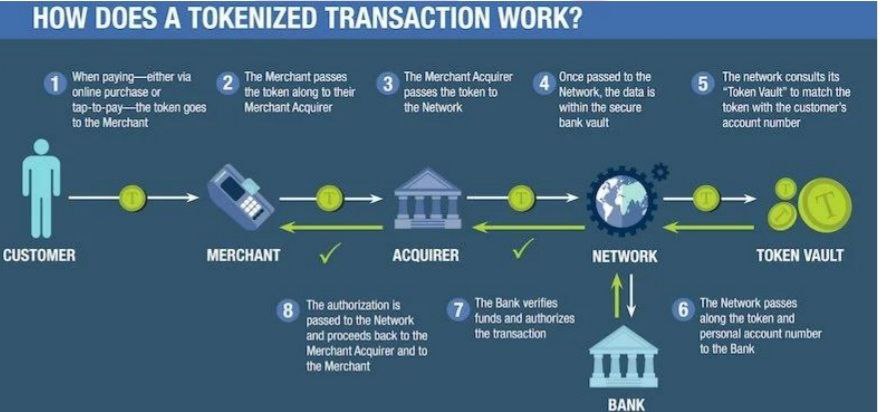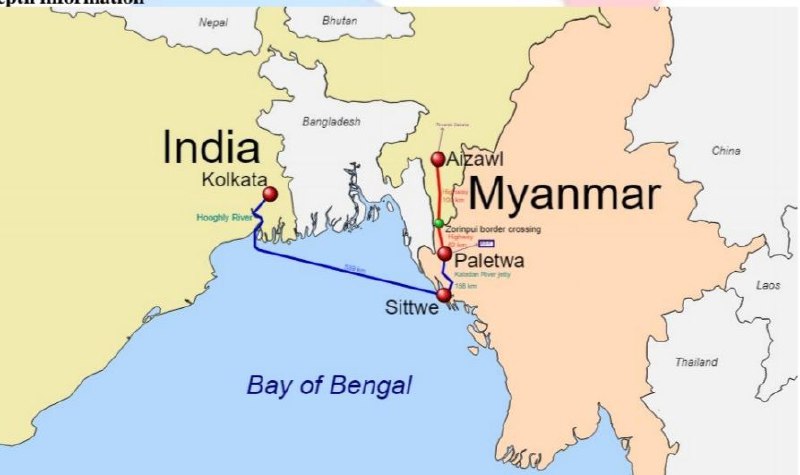CURRENT AFFAIRS 28-12-2021
Daily Current Affairs – Topics
- Tokenization and RBI issued new guidelines
- India and Myanmar
- Mission Indradhanush completed seven years
- Magnetar
- Archbishop Desmond Tutu
1. Tokenization and RBI issued new guidelines
#GS3-Inclusive growth and issues arising out of it.
Context:
- The Reserve Bank of India has extended the deadline for implementing card-on-file (CoF) tokenization regulations by six months, until June 30, 2022.
- According to the new requirements, online players must destroy any credit and debit card data held on their platforms and replace it with a token to protect consumers’ card information.
In depth information
What were the reasons for the stakeholders’ desire for an extension?
- While most major banks, including SBI, HDFC Bank, and ICICI Bank, are prepared for the transition, other players, mostly merchants, complain that their backend systems are not yet ready for the new regime and have requested more time to implement new regulations.
- The new regulation, if implemented in its current state of preparation, could generate severe disruptions and financial losses, particularly for retailers.
- Disruptions like these diminish faith in digital payments and cause consumers to return to cash-based transactions.
What is tokenisation, and how does it work?

- Tokenisation is the process of replacing genuine credit and debit card information with an alternate code known as a “token,” which is unique for each card, token requestor, and device.
Significance:
- Because the real card details are not shared with the merchant during transaction processing, a tokenised card transaction is deemed safer.
- Customers who do not have the tokenisation feature will have to provide their name, 16-digit card number, expiration date, and CVV each time they make an online purchase. This could be a time-consuming task.
To ensure a smooth implementation of tokenization, three phases must be completed:
- Token provisioning: the consumer’s card number should be able to be converted into a token, which requires the card networks to have the necessary infrastructure in place.
- Token processing: Consumers should be able to successfully finish their transaction using tokens.
- Consumers should be able to use the token for a variety of activities, including refunds, EMIs, recurring payments, offers, promotions, and guest checkouts.
2. India and Myanmar
#GS2-Bilateral agreements involving India
Context
- India’s Foreign Secretary recently paid a brief visit to Myanmar with a clear goal in mind: to strengthen ties with a key neighbour. His quest was largely successful, but there are still obstacles to overcome.
In depth information

Background information on Myanmar’s present political situation
- Derailment of Myanmar’s democratic transition: Since the military coup on February 1, 2021, the international community has been split on how to deal with the derailment of Myanmar’s democratic transition.
- For a decade, the country’s power-sharing structure between the military and elected officials worked well enough.
- The military command was shaken by the National League for Democracy’s (NLD) electoral victory in November 2020, which was led by Daw Aung San Suu Kyi.
- The Tatmadaw (Myanmar’s military) moved faster, seizing power in defiance of the Constitution and brutally suppressing the opposition.
- Global reaction: Western sanctions reflected global dismay, but others, notably as Russia, saw a chance to expand ties with the new leadership.
- China has taken immediate steps to stabilise and strengthen its relationship with the military regime.
- The Association of Southeast Asian Nations (ASEAN) first shown innovation with its ‘Five-Point Consensus’ formula, but its cohesiveness was harmed when Myanmar’s top leader, Senior General Min Aung Hlaing, refused to participate.
The position of India and bilateral concerns
- Shringla, the Indian Foreign Secretary, was successful in holding substantial discussions with key stakeholders during his tour.
- India’s viewpoint: As expressed to Myanmar, India’s position is identical to and supportive of ASEAN’s: release of political prisoners, resolution of disputes via discussion, end of “any violence,” and complete collaboration with ASEAN.
- Assistance for capacity building: In recent years, India has aided Myanmar with capacity-building programmes aimed at bolstering the country’s democratic transition.
- This support is still accessible, but it does not imply that India will mediate in the military-NLD confrontation.
ASEAN will have to shoulder this responsibility.
- Concerns in India: India’s main worries about border security and stability in its neighbourhood were strongly expressed, particularly the apparent intensification of anti-India militant activity.
- The second issue is that of refugees, which is a result of Myanmar’s instability. Hundreds of thousands of Myanmar refugees have sought refuge in Mizoram.
- Only a political settlement in Myanmar, achieved through negotiation, will be able to reverse this trend.
- Economic cooperation has always been a prominent topic of discussion in all bilateral negotiations with Myanmar.
- India’s long-delayed commitment to “rapid implementation” of megaprojects like the Trilateral Highway and the Kaladan project lies at the heart of this.
a path forward
- China isn’t Myanmar’s lone ally: India retains significant stock in the country, which it must now carefully utilise.
- It is reflected in Senior General Min Aung Hlaing’s exceptional gesture of receiving Mr. Shringla and holding thorough conversations in Yangon. This is a unique situation.
- Shringla’s departure from etiquette showed contemporary political realities that should be carefully considered when weighing the notion that China is Myanmar’s only friend.
- Utilize the benefits of the visit: India should capitalise on the benefits of this visit and maintain momentum by inviting Myanmar’s Foreign Minister, as well as other key stakeholders, to India for discussions with their counterparts.
- Conclusion
- The only goal should be to re-establish Myanmar as “a stable, democratic, and federal union.”
3. Mission Indradhanush completed seven years
#GS3- Health
Context
- In 2014, Mission Indradhanush was started as a specific initiative to increase India’s 100% immunisation coverage.
- Vaccination coverage among children aged 12 to 23 months has improved to 76.4 percent after seven years.
In depth information
Ministry of Health and Family Welfare, Government of India
- The goal is to increase vaccination coverage for all children in India. Its goal is to reach all children who are unvaccinated or only partially vaccinated against vaccine-preventable diseases.
- This programme immunises children from all socioeconomic, cultural, and geographic backgrounds in India.
- Pregnant women are also given the tetanus vaccination, ORS packets, and zinc pills are given out in case of severe diarrhoea or dehydration, and vitamin A dosages are given to strengthen children’s immunity.
- The Universal Immunization Programme (UIP) in India delivers free immunizations against 12 life-threatening diseases.
- It provides free vaccines to all children across the country to protect them from Tuberculosis, Diphtheria, Pertussis, Tetanus, Polio, Hepatitis B, Pneumonia, and Meningitis caused by Haemophilus Influenzae type b (Hib), Measles, Rubella, Japanese Encephalitis (JE), and Rotavirus diarrhoea, among other diseases. (Vaccines for rubella, JE, and rotavirus are available in some states and districts.)
Phases:
- Phase I began in 2015 with a weeklong special intensive immunisation effort in 201 high-priority districts for four months.
- Phase II of Mission Indradhanush covers 352 districts across the country, with 279 of them having a medium focus and the rest 73 having a high focus.
- From 7 April 2016, Phase III of Mission Indradhanush was began, comprising 216 districts.
- Arunachal Pradesh, Assam, Manipur, Meghalaya, Mizoram, Nagaland, Sikkim, and Tripura were included in Phase IV of Mission Indradhanush, which began on February 7, 2017. In April 2017, it was pushed out to the rest of the country.
- The Mission has also inoculated around 97 lakh pregnant women.
Significance
- India’s Mission to Be Healthy Indradhanush has ensured that every infant and mother is immunised in order to eradicate diseases and establish a healthy India.
- Campaigns are well planned at all levels: Develop particular programmes to reach the unreached children in over 400,000 high-risk communities such slums, construction sites, brick kilns, nomadic sites, and hard-to-reach locations.
- Effective communication and social mobilisation efforts: Increase community participation in the routine immunisation programme by generating awareness and demand for immunisation services through need-based communication strategies and social mobilisation activities in the mass media, mid media, interpersonal communication (IPC), school and youth networks, and corporate.
- Intensive health-care officials and front-line staff training: Increase the capability of health officials and staff involved in routine immunisation activities in order to provide high-quality immunisation services.
- Create a structure for accountability through task forces: Strengthening district task forces for immunisation in all districts of India and ensuring the use of concurrent session monitoring data to fill gaps in implementation on a real-time basis will increase district administrative and health machinery involvement and accountability/ownership.
Issues
- There needs to be more awareness about vaccines, because life is a valuable notion that is absolutely absent.
- Vaccination produces fever, and parents do not want to stay at home to care for their children.
- Migrants who speak various languages are the biggest stumbling block. Immunization is not a priority for these migratory labourers, so persuading them to get their children vaccinated is difficult.
- More than 28% of children were not vaccinated because their caregivers did not believe vaccines were necessary, while not knowing about vaccines was the second most common reason for unvaccinated children.
- Not knowing where to get immunised: Many rural residents are unaware of where they may get their children immunised.
- Wrong advice: According to others in the area or nearby, the expense of immunisation is too high and out of reach for the poor.
- Factory owners: don’t take responsibility or take time off because this is a 24-hour job. The employees do not want to forfeit even a single day’s pay to care for the infant.
- Vaccine side effects include: The BCG vaccine results in swelling, whereas the pentavalent vaccine results in a one-day fever.
4. Magnetar
#GS3- Space,Sci & Tech
Context
- For the first time, an international team of researchers has been able to measure the properties of a flare on a distant magnetar.
In depth information

What is a Magnetar, exactly?
- Magnetars are the universe’s most magnetic stars.
- It’s a rare compact neutron star with plenty of energy and magnetic.
- It’s a rare sort of neutron star with an extremely intense magnetic field as its defining feature.
- The field is a trillion times stronger than the Earth’s and 1,000 times greater than a regular neutron star.
- Magnetars are extremely rare, with just around thirty having been discovered so far in the Milky Way.
What is the title of the most current study?
- The magnetar in question is around 13 million light years away, pointing in the direction of NGC 253, a notable galaxy in the Sculptor group of galaxies.
- Its flare ejected as much energy as the Sun would in 100,000 years in a fraction of a second.
- It was accidentally captured by the International Space Station’s Atmosphere-Space Interactions Monitor instrument (ASIM) on April 15, 2020.
- This is the first investigation to define a flare from a magnetar that is so far away.
What causes magnetars to form?
- Massive stars, which have masses between 10 and 25 times that of the Sun, eventually collapse and shrink to produce neutron stars, which are extremely compact objects.
- Magnetars, a type of neutron star with a strong magnetic field, are a subgroup of these neutron stars.
- These are extremely dense and rotate at incredible rates, with rotational periods ranging from 0.3 to 12.0 seconds.
What distinguishes Magnetars?
- Flares of violence
- The observed big flare lasted about 160 milliseconds and emitted 1039 joules of energy at that period.
- In a tenth of a second, the flare emitted as much energy as our Sun will emit in 100,000 years.
- Starquakes
- Instabilities in their magnetosphere, or “starquakes” formed in their crust — a stiff, elastic layer about one kilometre thick – are thought to cause magnetar eruptions.
- In the magnetosphere, this creates waves, and the interaction between these waves causes energy dissipation.
Significance
- Multiple pulses were discovered, with the first emerging lasting only a few tens of microseconds, significantly faster than known extreme astrophysical transients.
- Not only will studying these flares aid our grasp of magnetar physics, but it will also aid our understanding of rapid radio bursts, one of astronomy’s most perplexing occurrences.
Conclusion
- Magnetars are neutron stars with the most powerful magnetic fields ever discovered.
- They can be a thousand times brighter than conventional neutron stars and have a strength of 10 trillion times that of a refrigerator magnet.
5.Archbishop Desmond Tutu
#Important person in news
Context
- Archbishop Desmond Tutu, a Nobel Laureate and a veteran of South Africa’s struggle against white minority rule, died on December 26th at the age of 90.
In depth information

- Desmond Tutu is a well-known African leader (1931- 2021)
- Tutu was a South African Anglican bishop who received the Nobel Peace Prize in 1984 for his contribution in the fight against apartheid in the country.
- He saw the regime come to an end a decade later, and he oversaw a Truth and Reconciliation Commission tasked with uncovering atrocities committed during those dark days.
- Both the black majority and the white minority saw him as the nation’s conscience, a lasting tribute to his faith and spirit of reconciliation in a divided country.
His well-known works
- Tutu promoted the idea of South Africa as “the Rainbow Nation” during the country’s democratic transition in the early 1990s.
- In a country historically associated with the rigid distinction of white and black under the Apartheid system, the phrase was intended to encapsulate the togetherness of multi-culturalism and the coming together of individuals from many different cultures.
- Tutu was named head of the Truth and Reconciliation Commission by South African President Nelson Mandela in 1995, which investigated claims of human rights violations during the apartheid era.
Our Courses
Watch Our Videos on YouTube

